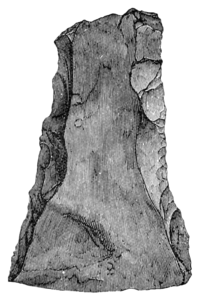It must be at once admitted that there are some of these "axes" which could never have been used for cutting, but these may be regarded as imperfect, and are certainly not to be taken as normal specimens. It is true that the two surfaces, constituting the edge, form a very obtuse angle with one another, but we must remember that if this detracts from the sharpness, it adds greatly to the strength. Moreover, the angle is almost exactly the same as that which we find in the adze of the New Zealanders and other South Sea Islanders. Figs. 120–122 represent a recent adze, brought by the Rev. R. Taylor from New Zealand, and now in the British Museum, which very closely resembles the typical axes of the Kjökkenmöddings. The edge, indeed, is polished, but is after all not smoother than the natural fracture of the flint. The projection on the under side of the Danish specimen (fig. 119) is accidental, and due to some peculiarity in the flint. This face is usually as flat in the Danish specimens
Page:Prehistoric Times.djvu/110
96
PREHISTORIC TIMES



